
How to Save Money on Utilities While Living in an Apartment
We are a family of 7 operating on a single income, so working to save money on utilities while living in an apartment is an incredibly high priority. That said, the utility bill is probably one of the most annoying bills we receive each month.
I say annoying because this is one of the few bills we have full control over, but it really takes discipline. Despite our best efforts, we never know how hard this bill will hit each month.
This bill drives me nuts!

Our utility bills totaled $2,482.13 last year. That’s $206.84 per month! We are currently renting, so here’s a list of ways you can save money on utilities while living in an apartment. These work for all you homeowner folks as well!
How to Save Money on Utilities While Living in an Apartment
- Swap out old light bulbs for LEDs.
- Turn off the lights.
- Wash your goods and get out (the PG version of what we were told in boot camp).
- Replace your showerhead.
- Stop leaking electricity.
- Pay your bill on time.
- Use the dishwasher.
- Keep your refrigerator and freezer full.
- Open your windows in the warmer months.
- Put bubble wrap on your windows in the colder months.
- Make sure your ceiling fan is spinning in the right direction.
- Use a door seal to stop conditioned air from leaking.
- Recycle as much as you can—do it for the turtles!
- Use a humidifier and monitor humidity levels.
- Install thermal gaskets behind cover plates on outlets and switches on exterior walls.
- Don’t put a brick in the toilet tank to save water.
- Try to avoid peak hours.
- Call your power company for an audit.
Keep reading to explore these ways to lower your electric bill.
Swap out old light bulbs for LEDs.
The old school incandescent bulbs from our childhood suck. Just don’t use them anymore. CFLs (compact fluorescent lamps), aka the weird twisty bulbs, are better, but you have to give them a minute to warm up. Our house is busy—we don’t have time to wait on a lightbulb. Also, CFLs contain small amounts of mercury, and we all know from high school science class that mercury isn’t the best thing to have around.
LED (light-emitting diode) bulb types are by far the best and most efficient. It’s pretty simple, just use them. Switching out your light bulbs is a fantastic way to save money on your utilities while living in an apartment. Nowadays, a good LED bulb runs roughly $5, and switching to LED light bulbs can help save approximately $8.33 a month. Just be sure to store the old bulbs so you can take your LED bulbs with you to your next place!
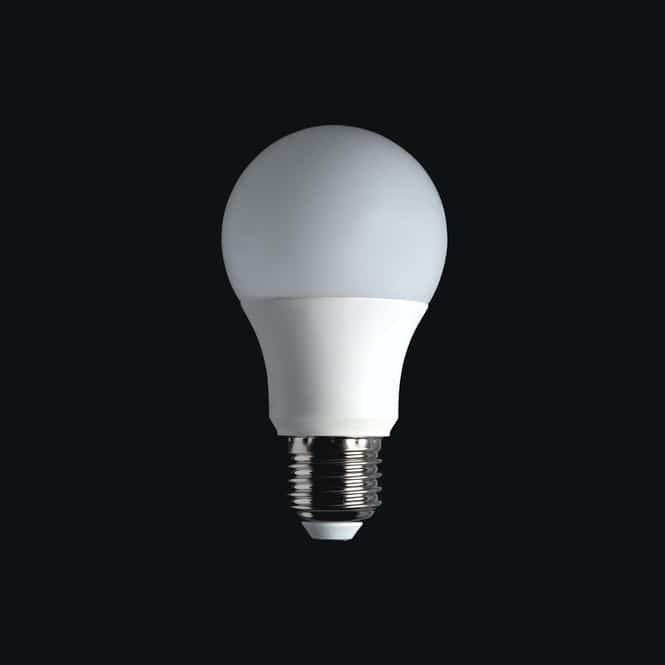
Turn off the lights.
If a light is on in a room and no one is in the room, does it still cost money?
Yes, yes it does!
I was convinced our kids had no idea how a light switch works. There have been days if we weren’t in an apartment, I would’ve removed their switches and replaced them with blank cover plates (don’t play with electricity if you don’t know what you’re doing). One day I was walking around flipping switches behind them like usual, then the idea popped into my head.
What if I start making them pay for it?
I started charging them 25 cents each time I found their room empty and turned off their light. Surprisingly, they took to the challenge. They started making sure they remembered to turn their lights off, but not before I made about five bucks. Of course, they caught me a couple of times as well. It’s a two-way street, and I paid up. This exercise was a good way for all of us to help keep each other accountable.
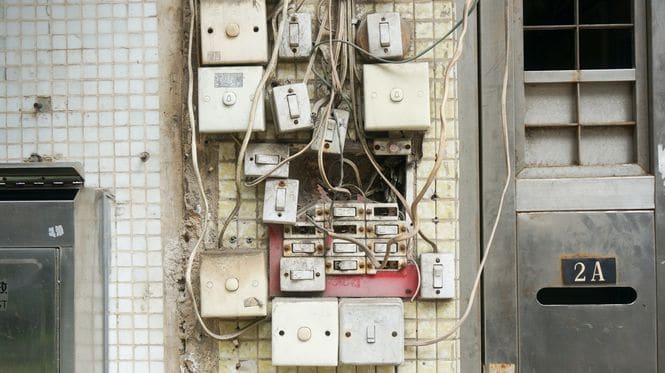
Wash your goods and get out (the PG version of what we were told in boot camp).
Some days while I sip on my hot morning cup of coffee, I wonder if our kids believe hot water is this amazing substance that magically appears from the showerhead, which makes a steaming hot 25-minute shower no big deal. We don’t need to gather costs per kilowatt-hour, showerhead gallons per minute, and figure all the math to know the shorter and less hot the shower, the less money it costs.
You can purchase some fancy timers to place in your shower that reduce water flow to a trickle after a set amount of time. I feel like those would be very useful and might try one out in the future.
For now, I rely on my cell phone. I set a 10-minute timer and leave it on the vanity counter. It’s time to get out when it starts chirping! For your morning routine, you can also create a 10-minute playlist to help spice up your morning while serving as a good reminder of when your shower time is coming to an end. “Danger Zone” by Kenny Loggins is always a good shower playlist pick.
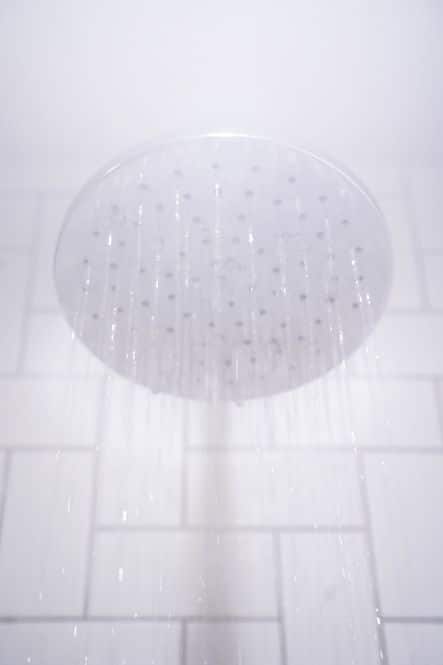
Replace your showerhead.
Showerheads are measured by how many gallons of water they dump each minute. This measurement is called flow rate, and it’s usually printed somewhere on your showerhead. There’s an act known as the Federal Energy Policy Act of 1992 that regulates showerhead manufacturers cannot exceed 2.5 gallons per minute in the United States.
If your showerhead was manufactured before 1992, then 1) it could very well be dumping more than 2.5 gallons of water every minute, and 2) you’re after my own heart, you frugal person you! There are many showerheads on the market that are even more conservative than 2.5 gallons per minute.
I just did a quick Google search for “1.5 GPM showerhead,” and the average cost looks to run between $15 to $30. Showerheads are simple to change, and you can put the old one back on when you move somewhere else. Let’s explore a little with a fancy line chart how much water our family of 7 would consume over the course of a year under showerheads with various flow rates.
(Click on the chart above to interact!)
Stop leaking electricity.
What are vampire loads? Electronics like computers, TVs, and game consoles are a few typical energy vampires that continue to use electricity while in standby mode. Vampire loads are responsible for 5 to 10% of our electricity use. That’s roughly one full month worth of electric costs over a 12 month period!
These devices are not only sucking your money, but they continue to spew carbon dioxide into the atmosphere while in standby. You can work to slay these energy vampires the good ole fashion way by merely unplugging them when not in use. You can also use a power strip to turn all devices off at once, which I use here at my “blogging station.” There are even smart power strips and individual smart plugs on the market these days that can help eliminate wasted energy by allowing you to monitor electrical consumption data and stop the flow of electricity by turning off the individual outlets completely—all from your cell phone.
Being mindful of our energy consumption puts money back in our pocket and reduces our carbon footprint. This seems like a low-hanging piece of fruit worth picking!

Pay your bills on time.
Paying your bill late is one of the best ways NOT to save money on utilities while living in an apartment! Our utility company charges a 10% late fee for any payment received after the due date, which is a significant and frustrating hit to the bank account! Let’s quickly run some numbers.
Say your utility bill is $164, you pay late, and there’s a 10% late fee. Take 164 multiplied by 0.1, and you’ll find you just threw $16.40 in the trash. That $16.40 would’ve made 22 loaves of homemade bread!
Being late on your utility bill can also cause you to lose any security deposit you may have had to pay when you had the service turned on. I remember when Angela and I were newlyweds and were living in a tiny one-bedroom apartment. We were living in Mississippi, 900 miles away from our families, and neither of us had ever had our “own place” with a real utility bill.
We were new customers with our local utility company, which required us to pay a $100 security deposit to have our electrical service turned on. Our $100 security deposit would be returned upon successfully paying our electricity bill on time for 12 straight months.
We were well on our way, and then I was late on month 11. I wasn’t late for any good reason. I just simply forgot. Just like that, our hundred bucks went POOF! It was now gone from our bank account forever. What a crappy way to save money on utilities while living in an apartment!
Angela and I had been married for less than a year, and as silly as it may sound, it was the first time in our marriage that I felt like I failed her.
After the beautiful experience of losing our security deposit, I wanted to make sure I never simply forgot to pay a bill again. I started tracking all the due dates of our monthly bills on a bill pay checklist. If you’re looking for ways to organize your monthly bills, click below to be directed to our easy peasy monthly bill pay checklist. Don’t get stuck wasting your hard-earned money on late fees!
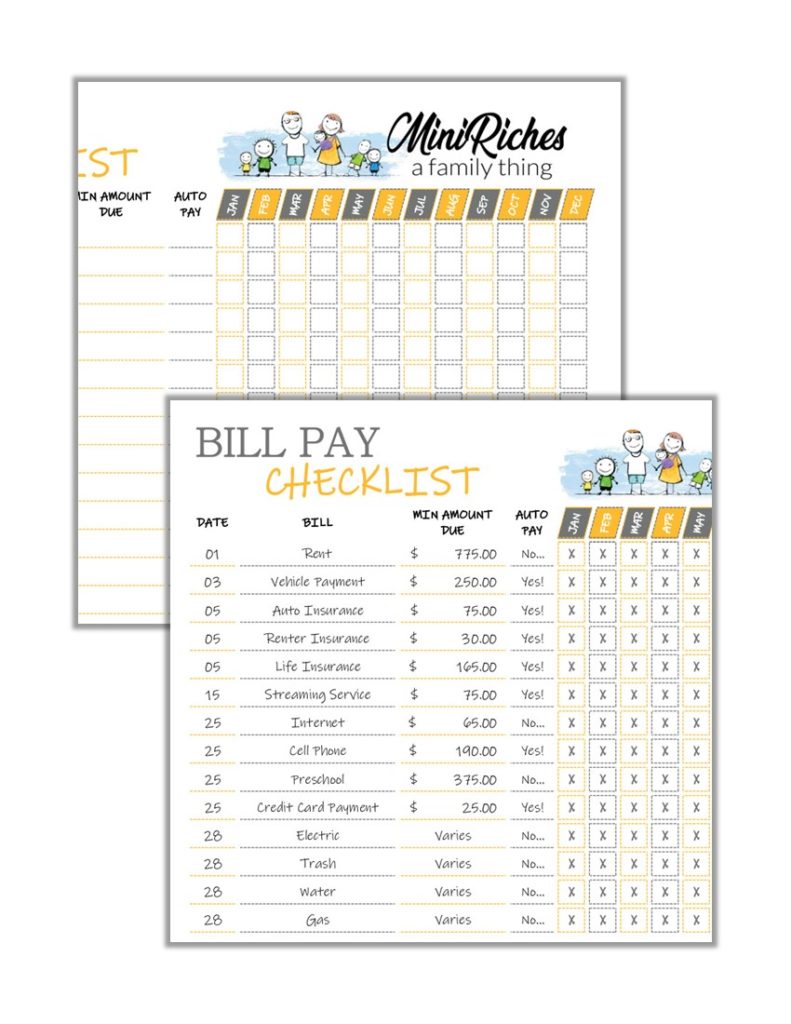
Bill Pay Checklist
Use the dishwasher.
Most of us know the dishwasher as this big box under the kitchen counter that makes it hard to hear the TV in the evening. Surely, using this thing is just for the wasteful, lazy folks who don’t want to wash the dishes by hand.
What if I told you this is absolutely false?
The average dishwasher uses just 4.5 gallons of water, while hand washing dishes can use 20 gallons! The key takeaway here is using the dishwasher not only saves you money, but it saves you time. If the place you’re renting doesn’t come with a dishwasher, I’ve found there are several different types of portable and countertop dishwashers on the market—type “countertop dishwasher” into a Google search.

Keep your refrigerator and freezer full.
Our fridge opens and closes more than a dog trying to eat peanut butter. We’re a family of 7, so there’s not a whole heck of a lot we can do about that. Keeping the fridge and freezer full, but not too full, helps cut back on electricity. The cold food acts as insulation and lessens the amount of time the compressor has to run to keep everything cold.
Make sure you don’t jam your freezer too full, though. We try to keep our refrigerator 70% to 85% full while being sure not to block any vents or interfere with proper air circulation.
If you don’t have a big enough family to keep your refrigerator full, then fill a few empty milk jugs with water and place them in your fridge and freezer. Don’t overfill the jugs in the freezer. Leave some space, so the water has some room to expand when it freezes.
You can now know you can save money on utilities while living in an apartment by keeping your refrigerator 70% to 85% full. When you need to make space, you can simply remove one of the water jugs and set it to the side for when you need it again.
Another refrigerator hack is to raise the front rollers a bit. Raising the front won’t affect your refrigerator’s ability to function correctly in any way, but it will ensure the refrigerator doors can swing shut on their own. You will never come home from work again to find that your refrigerator ran all day because you left the door open slightly. You’re welcome.
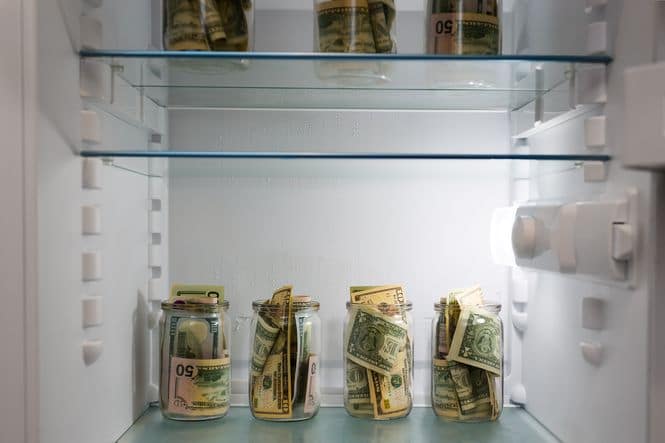
Open your windows in the warmer months.
Every home has windows, and using them can save money on your utility bill while living in an apartment in profound ways. Leaving windows open rather than running your central air conditioning system can easily save money while living in an apartment.
Simple thinking tells us it costs money to run the air conditioning system, but the crisp cool breeze outside is free, and every little bit helps when you’re working to stay within your monthly budget! Opening windows also helps to cycle fresh air into your home!
Put bubble wrap on your windows in the colder months.
You might not have much control over your apartment’s existing windows, but you do have control over what you put on the windows. Bubble wrap is nothing but trapped air, and the air is a natural insulator. Talk about ways to save money on utilities while living in an apartment—this is one of the best!
Cut a piece of bubble wrap to size, spray your window with water, and push the flat side against the glass. Make sure you are using the bubble wrap with the large bubbles and not the small bubbles. You can get large bubble wrap at any local home supply store, and you can even get it for free from some retail stores, like furniture stores, if you ask because they are likely throwing it out with the trash!
You don’t have to put bubble wrap on the whole window. Maybe you have a window you like to nature watch out of while drinking your cup of coffee in the morning. If that’s the case, you can try putting bubble wrap on only the top half of the window. Every little bit helps!
Just make sure the bubble wrap is cut to fit only on the glass. There’s a chance the bubble wrap will fall off if it is overlapping any of the window frame. The best part about this is you can save and reuse year after year. Simply pull the bubble wrap off once the colder months turn into warmer months and store away until next season.

Make sure your ceiling fan is spinning in the right direction.
Did you know ceiling fans have a little switch on them that determines which direction the blades spin? During warmer months, you need to make sure your ceiling fan is rotating counterclockwise. The blades on your ceiling fan push the air downwards while turning counterclockwise, creating a wind-chill effect that helps you feel cooler.
When the colder months come along, you need to flip that little switch to make your ceiling fan spin clockwise. The clockwise rotation pushes the cold air up, causing the warm air that rose to your ceiling to come back down. This process allows you to knock your thermostat down a few degrees lower. Make sure to only use the low setting in the colder months, so you just move the hot air and not cool it.
When used right, not only are ceiling fans fantastic at helping save money on utilities while living in an apartment, but they are also super cheap to use. You can click here to go to a fun calculator where you can plug in your ceiling fan stats and see what it costs. It costs us approximately $0.03 to run our ceiling fan for 8 hours per day.
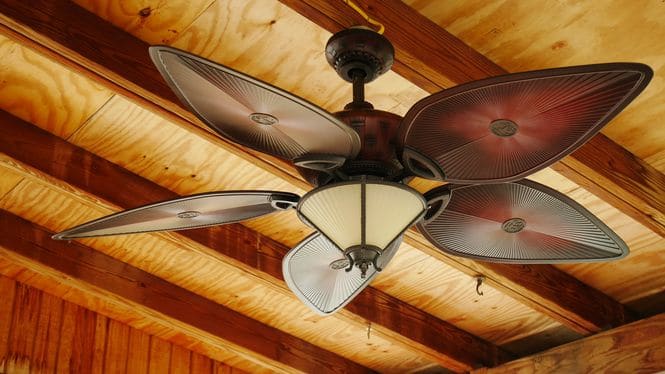
Use a door seal to stop conditioned air from leaking.
Many doors are a massive source of air leakage. Turn the lights off, close the blinds, and have a look around your door with it shut. Do you see any light peeking in around the edge of the door?
If you see the sunlight peeking through, then look a little harder, and you’ll see your money leaving through those gaps too!
There’s a whole slew of door seal type products that you can purchase at your local home supply store for $10 or less that will help close those voids. If the gaps are at the bottom of the door that you don’t use very often, then you can simply roll up an old towel and push it up against the door. Angela and I used the towel hack for years to help save money on utilities while living in an apartment.
Recycle as much as you can—do it for the turtles!
Garbage pick up is sometimes included in your utility bill, and If you have access to a free recycling yard, then this is a no brainer. We have to buy special trash bags to put out for collection, so the fewer bags we use, the more we save.
We only fill two 13-gallon sized trash bags per week as a family of 7, and that’s because we recycle everything we can: cereal boxes, milk jugs, school papers, aluminum cans—it’s all recyclable. Recycling saves us anywhere from $5 to $10 each month, and let’s not forget to mention the enormous environmental savings.
Not only is recycling a great way to save money on utilities while living in an apartment, but the sea turtles appreciate it.

Use a humidifier and monitor humidity levels.
Have you ever noticed that chill in the winter months soon after your furnace kicks off? Does it seem like your furnace is kicking back on after what seems like not even 10 minutes? Dry air can very well be the culprit!
Dry air can also cause eye and nose irritation in otherwise healthy people. Moisture in the air helps hold heat and can also help you avoid colds and flu! Keeping the humidity level around 55% will help reduce drafts in the colder months. For around $10, you can purchase a simple hygrometer, which monitors humidity levels in your home.
When your furnace shuts off, the moisture in the air will hold the heat and keep your furnace off longer. Keeping the humidity level around 55% also helps to cut down on sickness by allowing airborne viruses to attach to water vapor droplets decreasing the likelihood that airborne viruses will survive the journey from one person to another.
Monitoring humidity levels is not only a great way to save money on utilities while living in an apartment, but it’s also good for your health in general. I’ll call that a win-win!
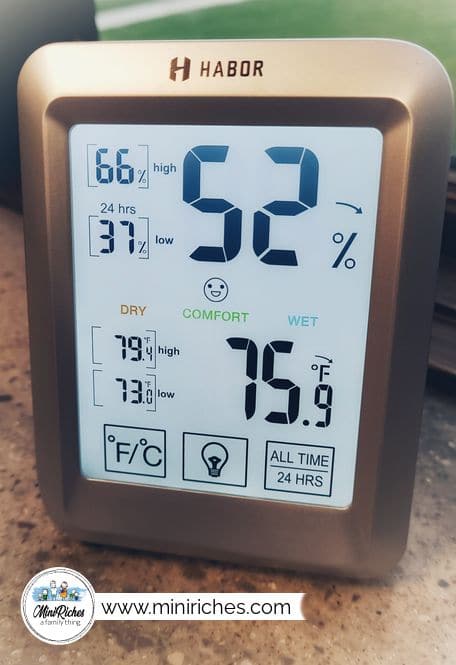
Install electrical outlet gaskets behind cover plates on exterior walls.
You would be so surprised to see how much conditioned air escapes through electrical boxes on exterior walls. Electrical outlet gaskets are pieces of foam sized to fit behind cover plates and reduce heat loss by preventing cold air from entering the space.
These things are super simple to install: one screw for outlets and two screws for switches. You just take the cover place off, put the gasket in place, and screw the cover plate back on. If you know nothing about electricity, it wouldn’t be a bad idea to ask someone who does for a little help.
Landlords will often cover these types of costs because they are cheap and help increase the lifespan of the heating and air conditioning equipment. You can pick up a 6-pack of gaskets from your local home supply store for less than $3.00. Keeping conditioned air from escaping is a great way to save money on utilities while living in an apartment.
Don’t put a brick in the toilet tank to save water.
Back in the early 70s and 80s, a trend emerged to put a brick in your toilet tank to displace water. The idea was to use less water per flush. The problem is toilets are engineered to need a calculated amount of water to flush correctly.
The idea of displacing water in the toilet tank to save water can seriously impact how well your toilet removes waste. The icky waste your flushing down needs to be disposed of properly, which happens with the correct water amount. The amount of water required was determined by the engineers who designed your toilet.
Too little water and your waste may not travel as far into the sewage system as what is necessary. The other problem with using a brick is the potential for particulate matter entering your plumbing system as the brick degrades flush after flush.
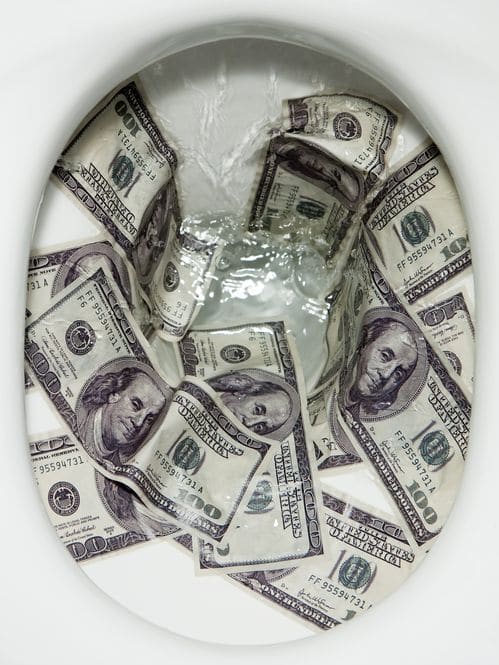
Displacing the water in your toilet is not an excellent way to save money on utilities while living in an apartment. It could potentially do the exact opposite if you start experiencing plumbing problems due to the weaker flush sessions.
If you would like to conserve water while doing your business in the bathroom, then talk to your landlord about upgrading to a newer toilet. Toilets manufactured in the 1980s up to 1994 use 3.5 gallons of water, but all toilets manufactured after 1994 are limited to using no more than 1.6 gallons of water per flush.
Another toilet water saving hack, and one that is definitely not for everyone, is the “If it’s yellow, let it mellow. If It’s brown, flush it down.” approach.
Try to avoid peak hours.
Electricity is charged using a measurement known as a kilowatt-hour (kWh), which is equal to 1,000 watts of power for a 1-hour time period. The average cost per kWh in the United States is around $0.12.
For example, say you have a 42-inch LED TV that uses 79 watts, and you spent 6 hours being a couch potato today. You could calculate how much your favorite movie marathon just cost you by multiplying 79 by 6 and then dividing by 1000. This formula calculates to 0.474 kWh, which equals $0.06 when multiplied by $0.12. In this example, you spent $0.01 per hour of binge-watching—not bad! You can use this calculator to work up some more energy consumption to your heart’s delight!
Your 42-inch LED TV isn’t a colossal electricity hog, though, unlike big appliances like your clothes washer and dryer. Depending on where you live, your electric company may charge different amounts per kWh during peak hours to promote energy conservation and better cover their operational expenses.
Peak hours are the times of day when electrical demand is at the highest, which is typically in the morning when folks are getting ready for the day, and in the evenings when the family returns home.
Call your electric company and ask two things: 1) do they charge different rates for peak hours dependent on the time of day, and 2) from what time to what time are the peak hours. Now you can take advantage of the delay start feature on many major appliances to run during off-peak hours, i.e., setting the delay start on your clothes washer to start at 3 am.
Your electric bill is 100% determined by the number of kilowatt-hours you used in the month. Hence, anything you can do to reduce your kilowatt-hours usage is a great way to save money on utilities while living in an apartment.
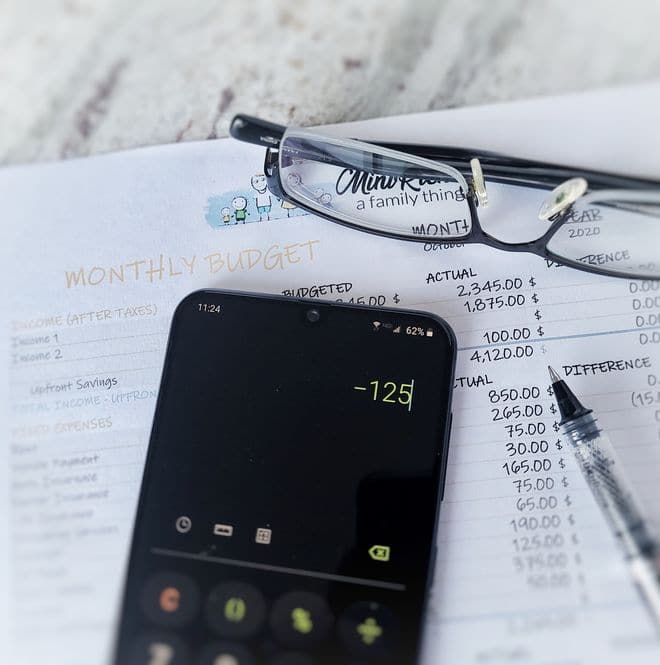
Call your power company for an audit.
Many power companies offer to complete an energy audit free of charge! This is a great way to save money on your utilities while living in an apartment. An energy audit will tell you the main areas you can cut back on to decrease consumption, or at the very least, give you some bullet points when discussing necessary upgrades with your landlord.

Great ideas I do use some of them. Have you talked to your utility company abut being on a budget plan that is a good money saver.
We looked into budget billing a few years ago but decided against it. Budget billing has its pros, but it has its cons as well. One of the biggest cons for me was the false sense of security that can lead to a potential high year-end bill if more energy is used than planned throughout the year. Like everything else, budget billing is something to look into and then decide if it’s right for you or not.
Excellent tips! I try to do most of these things already, but I’ll be using some you suggested. It’s surprising how bills add up even when living in an apartment. Thanks for sharing. 🙂
It is shocking how it all adds up! We hope they help and let us know how they go. Every little bit helps!